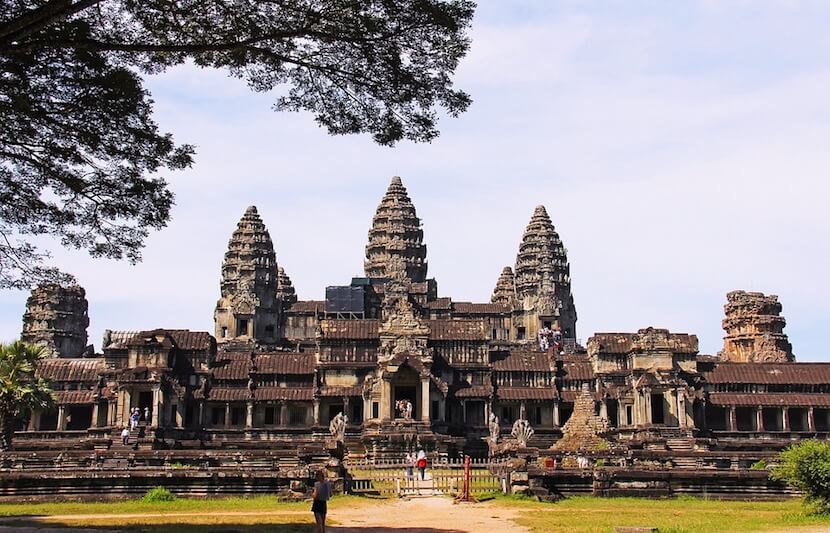The stone monuments of Angkor, an ancient city in modern day Cambodia, have long left scholars curious about the reason for its collapse in the 15th century.
Founded in the 9th century, Angkor was built upon an incredibly extensive infrastructure. Its complex network of canals and reservoirs captured, stored and delivered water both for flood control and agricultural uses to all parts of the city, covering an area of more than 1,000 square kilometers, or 386 square miles.
Now, a team of interdisciplinary researchers led by the University of Sydney points to extreme climate change that put too much stress on the city’s overly complex infrastructure as an explanation for its fall.
The team’s findings suggest the importance of building resilience into today’s urban networks in the face of an increasingly frequent extreme weather events, such as floods and droughts.
“Vulnerability of complex networks to external (and internal) stresses is a specific area of complex systems, and so we were excited to consider a joint multi-disciplinary approach combining archaeology, geosciences and complex systems,” said Mikhail Prokopenko, a professor of complex systems at the University of Sydney and director of the Complex Systems Research Group.
Now published in the journal Science Advances, the research was conducted as part of the Greater Angkor Project in conjunction with the University of Sydney’s CRISIS initiative, which models social risks and extreme events.
The study
Using an in-depth mapping model, the researchers concluded that the city’s network that had grown overly complex ultimately reached the tipping point for failure when the network had to suddenly cope with intense flooding from monsoon rains after a very long period of drought.
According to the model, the system must have been damaged most severely on major distribution nodes close to the flow source, which is where the system captures flow from the natural river.
And, in reality, they found that Siem Reap canal, which captured the majority of the natural flow from the Puok River, was severely damaged.
“In Angkor, as we argued, it was not just climate change or just aging complex water management network that caused a demise — but rather a combination of the two,” said Prokopenko.
Angkors of today
According to the researchers, despite the difference in time or types of infrastructure, the story of Angkor is a warning to modern cities.
“We found that infrastructural networks in preindustrial urban environments in fact share very common topological and functional characteristics with modern complex networks,” Prokopenko said in a statement.
Modern cities run on extremely interconnected and complex networks, such as roads, water infrastructure and power grids that sure can make things faster, but can also break down entirely with just a small outage in one part of the network.
The Northeast blackout of 2003 is a perfect example. On August 14, 2003, 21 power plants shut down affecting 50 million people across the eastern U.S. and Canada. The trigger was just one power plant that shut down unexpectedly when overgrown trees came in contact with a power line in Ohio, leading to a massive chain reaction.
Coupled with extreme weather events, cities all over the world are highly vulnerable.
For example, according to a CNN report, ever since the monster Hurricane Maria hit Puerto Rico in 2017, more than 3.4 billion hours of electricity have been lost, affecting more than 75 percent of residents and making it the largest blackout in U.S. history and the second largest in the world. In April, more than seven months after the hurricane, 53,000 households were still without power.
The researchers suggest that the modern problem is getting way bigger than just climate change.
“It is not just extreme climate change that modern cities need to be protected from, as there are other threats related to population dynamics, pandemics, social unrest, old and aging infrastructure (for example, power grids), as well as ecological disruptions,” said Prokopenko.
“It is precisely a combination of these interdependent factors that form a recipe for a disaster.”
Building resilient cities
Cities are not going away any soon. In fact, they are only growing.
According to the United Nations, 55 percent of the world’s population currently live in urban areas and the number is expected to rise to 68 percent by 2050.
Knowing the future lies in cities, the researchers stress the importance of building resilience into urban infrastructure.
For example, cities can increase alternative flow paths or keep systems in modules so that, even when one part goes off, the failure can be limited to the local area.
Even going beyond these, Prokopenko advises the inclusion of “optimal distribution and placement of monitoring and managing resources” and urges that city planners “start thinking in terms of inter-connected complex systems.”
The study of complex systems looks at how small parts of a system are indirectly related to each other to affect the collective behaviors of a system. One of the pioneers of the field, the University of Sydney offers a postgraduate degree in complex systems.
“If we don’t build resilience into our critical infrastructure, we may face severe and lasting disruptions to our civil systems, that can be intensified by external shocks and threaten our environment and economy,” Prokopenko said in a statement.
The researchers are planning to apply complex systems methods to Greater Sydney population dynamics modeling and studies of pandemics.
“So one ambitious goal is to create a model for multiple concurrent dynamics: infrastructure, demographics, epidemics, and experiment (in simulation) with critical ‘what-if’ scenarios,” Prokopenko said.



